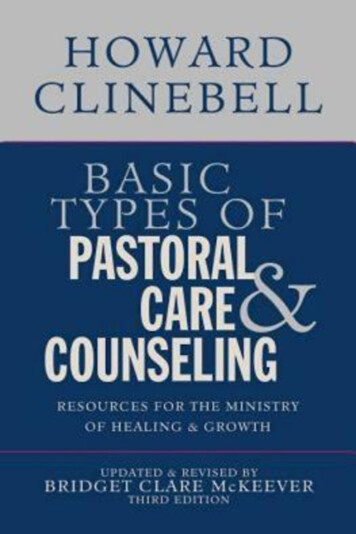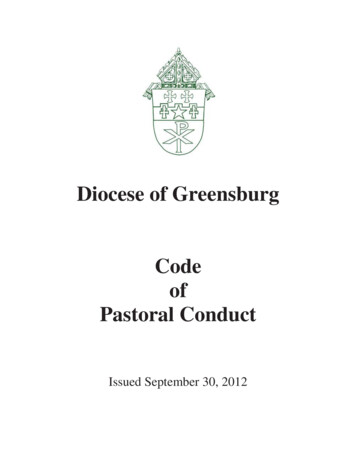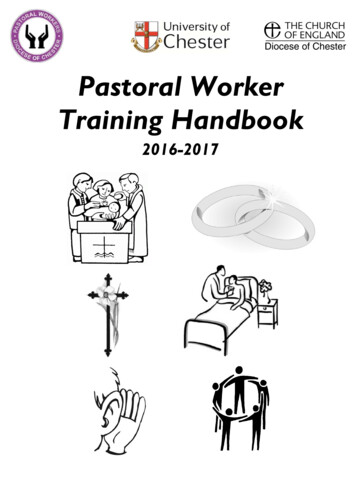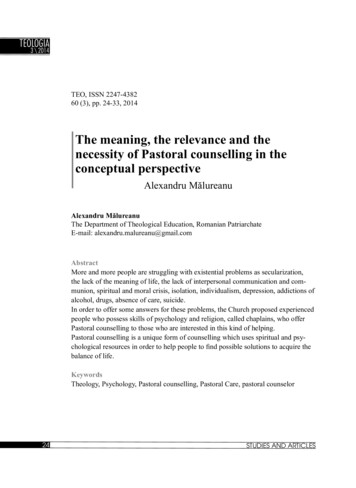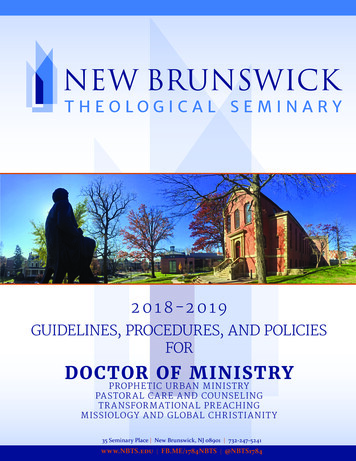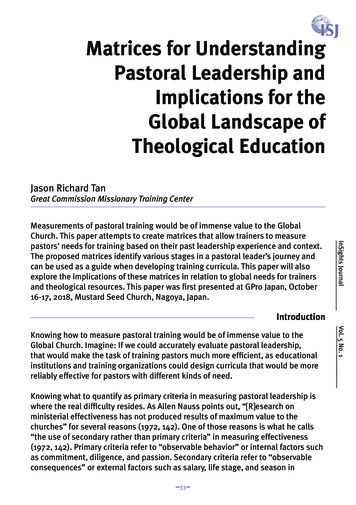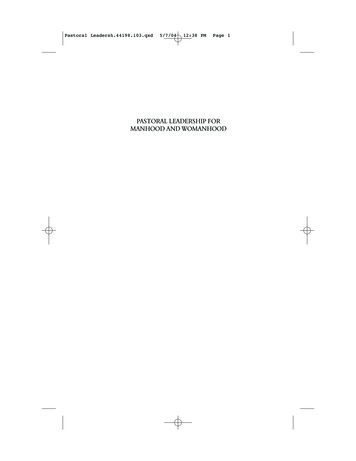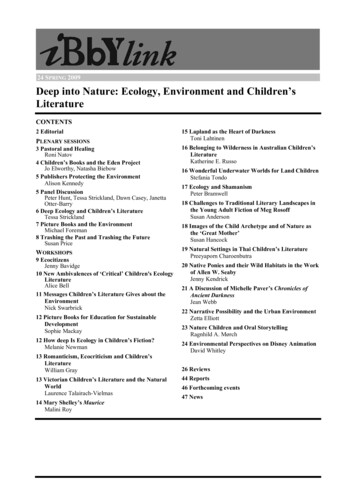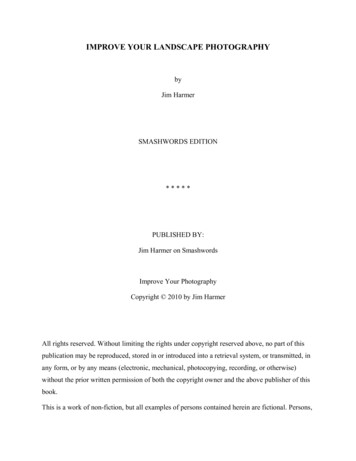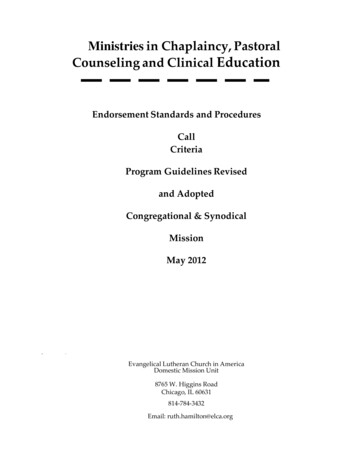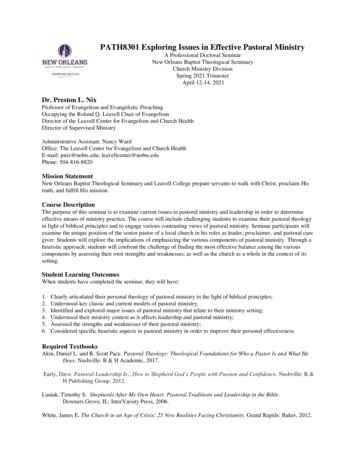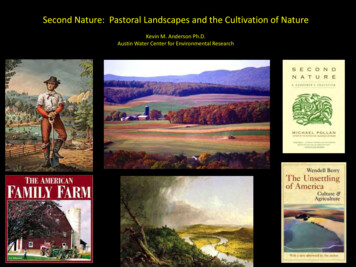
Transcription
Second Nature: Pastoral Landscapes and the Cultivation of NatureKevin M. Anderson Ph.D.Austin Water Center for Environmental Research
NatureThe literary critic Raymond Williams famously observed that the“nature” is perhaps the most complex word in the Englishlanguage because,"The idea of nature contains, though often unnoticed, anextraordinary amount of human history.“Raymond Williams, "Ideas of Nature“ 1983
Pastoral Imports to AmericaClassical Western Ideas of NatureCicero and the Iterative NaturesFirst nature - wilderness - is the realm of the gods, but it isalso the raw material for second nature.In De natura deorum Cicero wrote,"We sow corn, we plant trees, we fertilize the soil byirrigation, we dam the rivers and direct them where wewant. In short, by means of our hands we try to create as itwere a second nature within the natural world."Jacopo Bonfadio wrote in 1541 that formal gardens make a“third nature, which I would not know how to name.”The illustration shows a distant mountain (first nature)giving way to cultivated agricultural land (second nature)and then a formal garden (third nature).Frontispiece to l'Abbé de Vallemont'sCuriositez de la nature et de l'art (1705)
Virgil’s Classical Agrarian Myth – Pastoral ArcadiaVirgil is credited in the Eclogues with establishing Arcadia as apoetic ideal that still resonates in Western literature and visual artsFortunate old man, here you’ll find the cooling shade,among familiar streams and sacred springs.Here, as always, on your neighbor’s boundary, the hedge,its willow blossoms sipped by Hybla’s bees,will often lull you into sleep with the low buzzing:there, under the high cliff, the woodsman sings to the breeze:while the loud wood-pigeons, and the doves,your delight, will not cease their moaning from the tall elm.
English Pastoral PoetryJohn Clare 1793-1864Sweet it is to wind the rill,Sweet with thee to climb the hill,On whose lap the bullock freeChews his cud most placidly;Or o'er fallows bare and brownBeaten sheep-tracks wander down,Where the mole unwearied stillRoots up many a crumbling hill,And the little chumbling mouseGnarls the dead weed for her house,While the plough's unfeeling shareLays full many a dwelling bare;Where the lark with russet breast'Hind the big clod hides her nest,And the black snail's founder'd paceFinds from noon a hiding-place,Breaking off the scorching sunWhere the matted twitches run.
English Pastoral PoetryGerard Manley Hopkins 1844-1889“Pied Beauty”GLORY be to God for dappled things—For skies of couple-colour as a brinded cow;For rose-moles all in stipple upon trout that swim;Fresh-firecoal chestnut-falls; finches’ wings;Landscape plotted and pieced—fold, fallow, andplough;And áll trádes, their gear and tackle and trim.“Binsey Poplars”Rural scene, a rural scene,Sweet especial rural scene.
Nature in Rural America
The Cultivation of Nature - Ecological Impacts of Native AmericansIn the first millennium A.D., the Indians who had burned undergrowth to facilitate grazingbegan systematically replanting large belts of woodland, transforming them into orchardsfor fruit and mast (the general name for hickory nuts, beechnuts, acorns, butternuts,hazelnuts, pecans, walnuts, and chestnuts) In Colonial times, one out of every four trees in between southeastern Canada andGeorgia was a chestnut Within a few centuries, the Indians of the eastern forest reconfigured much of theirlandscape from a patchwork game park to a mix of farmland and orchards. Enough forestwas left to allow for hunting, but agriculture was an increasing presence. The result was anew balance of nature.” Mann, 1491
The Cultivation of Nature – Eastern Agricultural ComplexThree Sisters AgricultureIndian Corn-Hills in Massachusetts“The next day [July 9, 1605] Sieur de Monts and I landed to observe theirtillage on the bank of the river [Saco River]. We saw their Indian corn, whichthey raise in gardens.Planting three or four kernels in one place, they then heap about it a quantityof earth with shells of the signoc before mentioned [the horseshoe crab,Limulus polyphemus].Then three feet distant they plant as much more, and thus in succession.With this corn they put in each hill three or four Brazilian beans [the kidneybean, Phaseolus vulgaris], which are of different colors.When they grow up, they interlace with the corn, which reaches to the heightof from five to six feet; and they keep the ground very free from weeds. Wesaw there many squashes, and pumpkins, and tobacco, which they likewisecultivate.The Indian corn which we saw was at that time about two feet high, some ofit as high as three. The beans were beginning to flower, as also the pumpkinsand squashes. They plant their corn in May, and gather it in September.”From American Anthropologist "Indian Corn-Hills in Massachusetts," Delabarre and Wilder, July 1920.
The Mississippian Cultural Landscape5000 yearsBeginning with the construction ofWatson Brake about 3400 B.C. in presentday Louisiana, nomadic indigenouspeoples started building earthworkmounds in North America nearly 1000years before the pyramids wereconstructed in Egypt.Serpent Mound in southern Ohio is a1,348-foot mound built about 1070 A.D.
The Mississippian Culture reached its climax about 1500 A.D.Cahokia
CahokiaGroupings of pyramids and burial mounds cover five square miles. The largest earthen pyramid is104 feet high and covers 16 acres.“Anyone who traveled up the Mississippi in 1100 A.D. would have seen it looming in the distance: afour-level earthen mound bigger than the Great Pyramid of Giza Cahokia was a busyport Covering five square miles and housing at least fifteen thousand people. Cahokia was thebiggest concentration of people north of the Rio Grande until the eighteenth century.”Mann, 1491
The Cultivation of NatureWestern Agricultural LandscapesIrrigation
The Cultivation of Nature – Agricultural Exchange
The Cultivation of American Nature
The Cultivation of American NatureJefferson and the American Agrarian Myth“Cultivators of the earth are the most valuable citizens. They are the most vigorous, the mostindependent, the most virtuous, & they are tied to their country & wedded to its liberty &interests by the most lasting bands.”1785 Letter to John JayThe yeoman farmer was portrayed as a self-reliantindividual, the bedrock of democracy.He owned a small farm and worked it with the helpof his family and was seen as simple, honest, healthybecause he lived close to nature.
Early American Pastoral PoliticsFederalists vs. RepublicansThe yeoman became a feature in American politics very early. The Federalist and Agrarian forces ingovernment were divided in opinion just following the Revolution.The Federalists, led by Alexander Hamilton, were in favor of a strong central government with most powerin the hands the landed few, and looked to commercial and industrial expansion.The Republicans, led by Thomas Jefferson, believed in the primacy of local government and a mainlyagrarian national economy, based on small independent farmers.Jefferson’s Republicans favored the agrarian economy because farming was a “noble” profession as it keptpeople out of the corrupt cities and close to the soil and God.
The Development of the 19th Century American Pastoral VisionA. J. Downing 1815-1852In 1841 his first book, A Treatise on the Theory and Practice of Landscape Gardening, Adapted to NorthAmerica, was published to a great success; it was the first book of its kind published in the United StatesEditor of The Horticulturist magazine (1846–52)"There is a moral influence in a country home."
Urban Arcadia - Olmsted1822 –1903
The Arcadian or Pastoral State (1834) - Thomas ColeThe Course of Empire is a five-part series of paintings created by Thomas Cole in the years 1833–36. It isnotable in part for reflecting popular American sentiments of the times, when many saw pastoralism as theideal phase of human civilization, fearing that empire would lead to gluttony and inevitable decay.The images reflect an idealized, pre-urban ancient Greece. This work shows mankind at peace with nature. Itsymbolizes that the environment has been altered, but not so much so that it or its inhabitants are in danger.
19th Century Arcadia in American LiteratureMargaret Fuller 1810-1850Susan Fenimore Cooper 1813-1894
The Cultivation of American NatureHenry David Thoreau and the Bean FieldMEANWHILE MY BEANS, the length of whose rows, added together, was seven miles already planted,were impatient to be hoed, for the earliest had grown considerably before the latest were in the ground;indeed they were not easily to be put off.What was the meaning of this so steady and self-respecting, this small Herculean labor, I knew not.I came to love my rows, my beans, though so many more than I wanted. They attached me to the earth,and so I got strength like Antæus.But why should I raise them? Only Heaven knows. This was my curious labor all summer — to make thisportion of the earth's surface, which had yielded only cinquefoil, blackberries, johnswort, and the like,before, sweet wild fruits and pleasant flowers, produce instead this pulse.Published 1854
Agricultural KnowledgeI was determined to know beans. When they were growing, I used to hoe fromfive o'clock in the morning till noon, and commonly spent the rest of the dayabout other affairs. Consider the intimate and curious acquaintance one makeswith various kinds of weeds — it will bear some iteration in the account, forthere was no little iteration in the labor — disturbing their delicateorganizations so ruthlessly, and making such invidious distinctions with his hoe,levelling whole ranks of one species, and sedulously cultivating another.Wild and Domesticated ConnectedWe are wont to forget that the sun looks on our cultivated fields and on theprairies and forests without distinction. They all reflect and absorb his rays alike,and the former make but a small part of the glorious picture which he beholdsin his daily course. In his view the earth is all equally cultivated like a garden.
Making Arcadia19th Century Agricultural Utopian Communities
Post Civil War American AgrarianismThe Grange 1867Agrarianism refers to a social philosophy or politicalphilosophy which values rural society as superior tourban society, the independent farmer as superior tothe paid worker, and sees farming as a way of life thatcan shape the ideal social values.It stresses the superiority of a simpler rural life asopposed to the complexity of city life, with its banksand factories.National Grange of the Order of Patrons of Husbandry
Pastoral Rebellion 1879 – 1920sHenry George 1838-1897The Progressive Era andPopulist Revolt
Agrarian Arcadian and American back-to-the-land movements186419351970
This Agrarian Arcadian narrative/myth is still a powerful one in modern/postmodern urban America.
The Cultivation of American Nature20th Century Nature Conservation and the Land EthicA Sand County Almanac– Aldo Leopold On this sand farm in Wisconsin, first worn out and then abandoned by our bigger and better society, we tryto rebuild, with shovel and axe, what we are losing elsewhere. It is here that we seek—and still find—ourmeat from God. The land ethic: "A thing is right when it tends to preserve the integrity, stability, and beauty of the bioticcommunity. It is wrong when it tends otherwise.“ What more delightful avocation than to take a piece of land and by cautious experimentation to prove howit works. What more substantial service to conservation than to practice it on one's own land?”Aldo Leopold 1887-1948
Meddling with the LandI have read many definitions of what is a conservationist, and written not a few myself, but I suspect that thebest one is written not with a pen, but with an axe. It is a matter of what a man thinks about while chopping,or while deciding what to chop. A conservationist is one who is humbly aware that with each stroke he iswriting his signature on the face of his land.Sportsmanship – Hunting and FishingThere is value in any experience that exercises thoseethical restraints collectively called “sportsmanship.” A peculiar virtue in wildlife ethics is that the hunterordinarily hos no gallery to applaud or disapprove ofhis conduct Voluntary adherence to an ethical codeelevates the self-respect of the sportsman, but itshould not be forgotten that voluntary disregard of thecode degenerates and depraves him.
Hunting and Dogs“October - Red Lanterns” from A Sand County AlmanacOne way to hunt partridge is to make a plan another is to wander, quite aimlessly, from one red lantern toanother. This will likely take you where the birds actually are. The lanterns are blackberry leaves, red inOctober sun Partridge hunting, then, is a creekside stroll, upwind, from one briar patch to another thedog, when he approaches the briars, looks around to make sure I am within gunshot My dog, by the way,thinks I have much to learn about partridges, and, being a professional naturalist, I agree.The first deer hunt
Rural Nature – Labor, Economy, and ChoresAldo Leopold – The Spiritual Dangers of not owning a farmThere are two spiritual dangers in not owning a farm. One is the danger of supposing that breakfast comesfrom the grocery, and the other that heat comes from the furnace.To avoid the first danger, one should plant a garden, preferably where there is no grocer to confuse theissue.To avoid the second, he should lay a split of good oak on the andirons, preferably where there is no furnace,and let it warm his shins while a February blizzard tosses the trees outside. If one has cut, split, hauled, andpiled his own good oak and let his mind work the while, he will remember much about where the heatcomes from, and with a wealth of detail denied to those who spend the week end in town astride a radiator.
Home Economics - Conservation and FarmingWendell Berry b. 1938But we cannot hope – for reasons practical and humane, we cannot even wish – to preserve more thana small portion of the land in wilderness. Most of it we will have to use. The conservation movementswings from self-righteous outrage to self-deprecation because it has neglected this issue. It s selfcontradictions can only be reconciled – and the conservation impulse made to function as ubiquitouslyand variously as it needs to – by understanding, imagining, and living out the possibility of “kindly use”Land Ethic – Kindly UseKindly use depends upon intimate knowledge, the most sensitiveresponsiveness and responsibility the understanding of kindly use inagriculture must encompass both farm and household 1977
Wildness in the Human Economy“Getting Along with Nature” Home EconomicsWhat I am aiming at – because a lot of evidence seems to point this way – is the probability that nature andhuman culture, wildness and domesticity, are not opposed but are interdependent.Authentic experience of either will reveal the need of one for the other.In fact, examples from both past and present prove that a human economy and wildness can exit togethernot only in compatibility but to their mutual benefit.1987
Agriculture and BiodiversityStudy of two Sonora Desert oasesOasis 1 in ArizonaPark Service removed the Papago Indians whohad lived and farmed there to make it a birdsanctuary, “an odd thing is happening to their“natural” bird sanctuary. They are losing theheterogeneity of the habitat, and with it, thebirds. The old trees are dying Summer annualseed plants are conspicuously absent withoutthe soil disturbance associated with plowingand flood irrigation, these natural foods forbirds and rodents no longer germinate.”Oasis 2 in MexicoThe other oasis still thrives because a Papago village is still there, still farming.Twice as many bird species are found at this oasis. Mr. Nabhan’s Papago friendRemedio, explained it this way: “That’s because those birds, they come wherethe people are. When the people live and work in a place, and plant theirseeds and water their trees, the birds go and live with them. They like thoseplaces, there’s plenty to eat and that’s when we are friends to them.”
Nonhuman PastoralistsDomesticated Animals
I think I could turn and live with animals, they are so placid and self-contain’d;I stand and look at them long and long.They do not sweat and whine about their condition;They do not lie awake in the dark and weep for their sins;They do not make me sick discussing their duty to God;Not one is dissatisfied—not one is demented with the mania of owning things;Not one kneels to another, nor to his kind that lived thousands of years ago;Not one is respectable or industrious over the whole earth.Walt Whitman
Dark PastoralOn-Farm Chicken ProcessingTom WaitsMurder In The Red BarnThere was a murder in the red barnMurder in the red barnThe trees are bending overThe cows are lying downThe autumn's taking overYou can hear the Buckshot hounds 'Cause there's nothin' strangeAbout an axe with bloodstains in the barnThere's always some killin'You got to do around the farmA murder in the red barnMurder in the red barn
The Cultivation of American NatureCalving Season
Rural scene, a rural scene,Sweet especial rural scene.Gerard Manley Hopkins“Binsey Poplars“
Classical Western Ideas of Nature Cicero and the Iterative Natures First nature - wilderness - is the realm of the gods, but it is also the raw material for second nature. In De natura deorum Cicero wrote, "We sow corn, we plant trees, we fertilize the soil by irrigation, we dam the rivers and direct them where we want.
